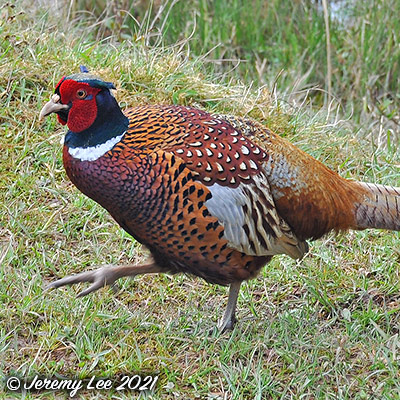
 |
|
Scientific Classifications explained » Amphibians » Ants » Aphids » Bees » Beetles » Birds » Bugs » Butterflies » Caterpillars » Damselflies » Dragonflies » Earwigs » Flies » Frog/Leafhoppers » Fungi » Galls » Grasshoppers » Harvestmen » Hoverflies » Lacewings » Ladybirds » Leaf Mines » Lichens » Mammals » Millipedes » Mosses » Moths » Sawflies » Slugs » Snails » Spiders » Trees » Wasps » Wild Flowers » Woodlice |
UK Nature > Birds > Phasianus colchicus

Scientific Name: Phasianus colchicus Common Name: Pheasant Phasianus colchicus, more commonly known as the Pheasant, are large, long-tailed gamebirds. The males have rich chestnut, golden-brown and black markings on their bodies and tails, with a dark green head and red face wattling. Females are mottled with paler brown and black. They were introduced to the UK long ago and more recent introductions have brought in a variety of races and breeds for sport shooting. Common and widespread in most of Britain, apart from the far north and west of Scotland. Least common in upland and urban. Usually seen in the open countryside near woodland edges, copses and hedgerows. Pheasants feed solely on the ground but roost in sheltered trees at night. They eat a wide variety of animal and vegetable type-food, like fruit, seeds and leaves as well as a wide range of invertebrates. |
|

https://www.uknature.co.uk is a website dedicated to showing the immense diversity of UK nature and wildlife. Our vast range of habitats, from lowland arable to snow covered mountains, from storm-ravaged coastlines to peaceful inland freshwater lakes and rivers, from dry, sandy heaths to deciduous and coniferous forests, all these habitats contribute to the abundance of UK nature. We have wild birds in huge numbers either residing or visiting our shores (597 recorded species as at July 2013) and we must also not forget the humble back garden with its grass lawns, flower beds filled with nectar rich flowers, shrubs and trees, all designed to attract huge numbers of insects such as bees, moths, butterflies and hoverflies; and finally the small ponds which provide safe havens for frogs, toads, newts and even slow worms and grass snakes. www.uknature.co.uk is the showcase for my personal passion, photographing uknature in all its glory. I sincerely hope you all enjoy the fruits of my labours. This site and all images contained therein is © Jeremy Lee 2004 - 2021. All Rights Reserved. Site design by Jeremy Lee. Site development & IT Support by Stuart Lee. |